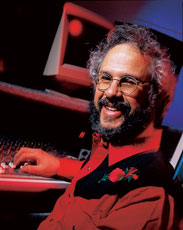By Steve Oppenheimer
(February 2000)
Despite all that has been written and said, a lot of people ignore basic hearing safety. To the extent that they are hurting only themselves, it’s their problem, but it’s still a drag.
On the other hand, in this era of increased workplace-safety awareness, organizations of music-industry professionals should insist on safe hearing practices at industry trade shows. Large trade shows tend to be loud to start with, and when it comes to music-gear shows, well, making sound is what musicians are about. But an ongoing, high-level sonic assault on our ears (and nerves) is obviously unhealthy, and major trade shows should regulate the sound level. Some do it better than others.
This February issue of EM is being distributed at the Winter National Association of Music Merchants show, where guitars, stage amps, drums, horns, and a host of electronic products often join in wild cacophony. NAMM demos and crowd noise can sometimes blur into a loud, ambient buzz that forces voices to rise to the straining point. According to NAMM’s rules, the maximum acceptable level at the periphery of a booth is 85 dB SPL, but those rules are loosely and inconsistently enforced. NAMM’s “sound police” threaten; they rarely act. I’d guess the ambient noise alone is close to 85 dB SPL. Contrast that with a recent Frankfurt Musikmesse show where, after several warnings, a major manufacturer was told to turn down or have its power cut off.
As a result, enjoying a demo at Winter NAMM can be a chore. It’s hard to listen to a conversation, let alone a new effects processor, while a drummer two booths away drowns you in waves of percussion. Sometimes it’s even hard to think.
In comparison, the U.S. Audio Engineering Society convention is more moderate. The AES show admittedly is smaller than Winter NAMM and hosts fewer musical-instrument manufacturers. Still, the organization’s attitude also must be credited for the show’s more bearable sound levels. According to the rules, sound-pressure levels at the boundary of a booth cannot exceed 70 dB, A weighted, and the show’s sound police enforce some degree of sonic restraint. Loud demos are supposed to be confined to soundproof booths or banished to separate demo rooms.
AES attendees are also reminded about hearing preservation by the Mix Foundation’s annual Technical Excellence and Creativity Awards ceremony, which benefits the House Ear Institute (www.hei.org), a nonprofit research and education center that studies the causes, prevention, and treatment of hearing loss. Although the institute exhibits at NAMM, it does not appear to get much cooperation or encouragement from the association.
Clearly, NAMM needs to get serious about improving the sonic environment at its trade shows. Stricter sound-level rules should be firmly enforced. The use of sound-isolation enclosures, portable acoustic treatment within booths, and acoustically treated, off-floor demo rooms should be encouraged. We might be able to hear all of the demos and conversations clearly for a change!
In the meantime, Winter NAMM attendees can find free earplugs at the House Ear Institute booth and EM’s booth (#W201), among others. We’re going to need them.
